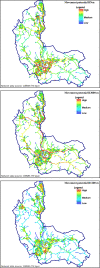Urban built environment configuration and psychological distress in older men: results from the Caerphilly study
- PMID: 23898839
- PMCID: PMC3735426
- DOI: 10.1186/1471-2458-13-695
Urban built environment configuration and psychological distress in older men: results from the Caerphilly study
Abstract
Background: Few studies have examined the impact of the built environment configuration upon mental health. The study examines the impact of objectively assessed land use and street network configuration upon psychological distress and whether this association is moderated by the natural environment and area-level deprivation.
Methods: In a community sample of 687 older men from the Caerphilly Prospective Study, built environment morphological metrics (morphometrics) were related to differences in psychological distress as measured by the General Health Questionnaire. Cross-sectional data were taken from the most recent (5th) phase. A multi-level analysis with individuals nested within census-defined neighbourhoods was conducted. Environmental measures comprised GIS-constructed land use and street network metrics, slope variability and a satellite derived measure of greenness.
Results: Reduced psychological distress was associated with residing in a terraced dwelling (OR=0.48, p=0.03), higher degrees of land-use mix (OR=0.42, p=0.03 for the high tertile) and having higher local-level street-network accessibility ('movement potential') (OR=0.54, p=0.03). Hillier topography with higher slope variability was associated with increased risks of psychological distress (OR=1.38, p=0.05).
Conclusions: The findings support our hypothesis that built environment configuration is independently associated with psychological distress. The study underscores the need for effective intervention in the planning and design of residential built environment to achieve the goal of health-sustaining communities.
Figures
Similar articles
-
Built environment configuration and change in body mass index: the Caerphilly Prospective Study (CaPS).Health Place. 2013 Jan;19:33-44. doi: 10.1016/j.healthplace.2012.10.001. Epub 2012 Oct 17. Health Place. 2013. PMID: 23178327
-
The relationship of built environment to perceived social support and psychological distress in Hispanic elders: the role of "eyes on the street".J Gerontol B Psychol Sci Soc Sci. 2009 Mar;64(2):234-46. doi: 10.1093/geronb/gbn011. Epub 2009 Feb 4. J Gerontol B Psychol Sci Soc Sci. 2009. PMID: 19196696 Free PMC article.
-
Neighbourhood green space, physical function and participation in physical activities among elderly men: the Caerphilly Prospective study.Int J Behav Nutr Phys Act. 2014 Mar 19;11(1):40. doi: 10.1186/1479-5868-11-40. Int J Behav Nutr Phys Act. 2014. PMID: 24646136 Free PMC article.
-
Identifying GIS measures of the physical activity built environment through a review of the literature.J Phys Act Health. 2011 Jan;8 Suppl 1:S91-7. doi: 10.1123/jpah.8.s1.s91. J Phys Act Health. 2011. PMID: 21350268 Review.
-
The built environment and mental health.J Urban Health. 2003 Dec;80(4):536-55. doi: 10.1093/jurban/jtg063. J Urban Health. 2003. PMID: 14709704 Free PMC article. Review.
Cited by
-
Dwelling characteristics and mental well-being in older adults: A systematic review.Heliyon. 2024 Sep 10;10(18):e37676. doi: 10.1016/j.heliyon.2024.e37676. eCollection 2024 Sep 30. Heliyon. 2024. PMID: 39309881 Free PMC article.
-
Exploring the Impacts of Housing Condition on Migrants' Mental Health in Nanxiang, Shanghai: A Structural Equation Modelling Approach.Int J Environ Res Public Health. 2018 Jan 29;15(2):225. doi: 10.3390/ijerph15020225. Int J Environ Res Public Health. 2018. PMID: 29382174 Free PMC article.
-
Does Walkability Contribute to Geographic Variation in Psychosocial Distress? A Spatial Analysis of 91,142 Members of the 45 and Up Study in Sydney, Australia.Int J Environ Res Public Health. 2018 Feb 6;15(2):275. doi: 10.3390/ijerph15020275. Int J Environ Res Public Health. 2018. PMID: 29415461 Free PMC article.
-
Education is power: preserving cognition in the UK biobank.Front Public Health. 2023 Sep 28;11:1244306. doi: 10.3389/fpubh.2023.1244306. eCollection 2023. Front Public Health. 2023. PMID: 37841724 Free PMC article.
-
Mental health benefits of long-term exposure to residential green and blue spaces: a systematic review.Int J Environ Res Public Health. 2015 Apr 22;12(4):4354-79. doi: 10.3390/ijerph120404354. Int J Environ Res Public Health. 2015. PMID: 25913182 Free PMC article.
References
-
- Evans GW, Wells NM, Chan HYE, Saltzmand H. Housing quality and mental health. J Consult Clin Psychol. 2000;68(3):526–530. - PubMed
-
- Weich S, Blanchard M, Prince M, Burton E, Erens B, Sproston K. Mental health and the built environment: Cross-sectional survey of individual and contextual risk factors for depression. Brit J Psychiatry. 2002;180(MAY):428–433. - PubMed
-
- Brown SC, Mason CA, Lombard JL, Martinez F, Plater-Zyberk E, Spokane AR, Newman FL, Pantin H, Szapocznik J. The relationship of built environment to perceived social support and psychological distress in hispanic elders: The role of “eyes on the street”. J Gerontol Series B Psychol Sci Soc Sci. 2009;64(2):234–246. - PMC - PubMed
Publication types
MeSH terms
Grants and funding
LinkOut - more resources
Full Text Sources
Other Literature Sources
Medical


